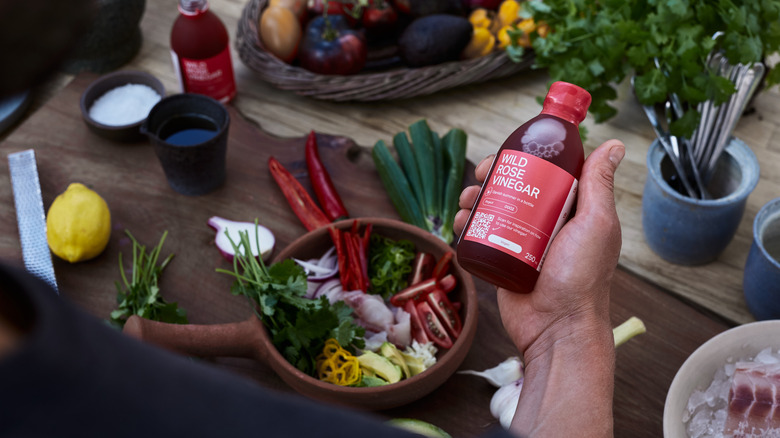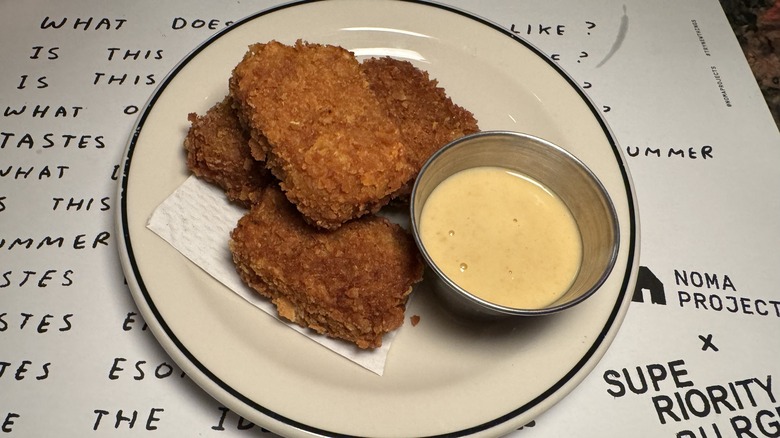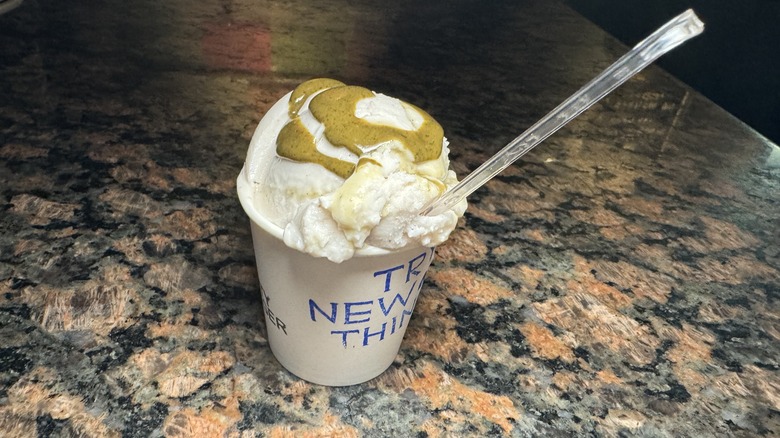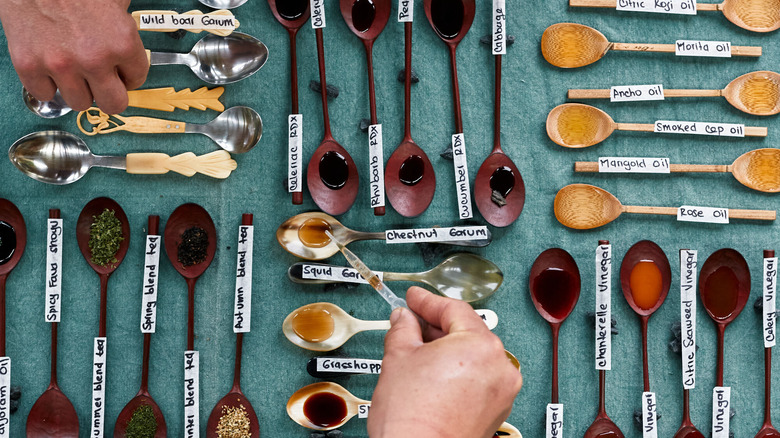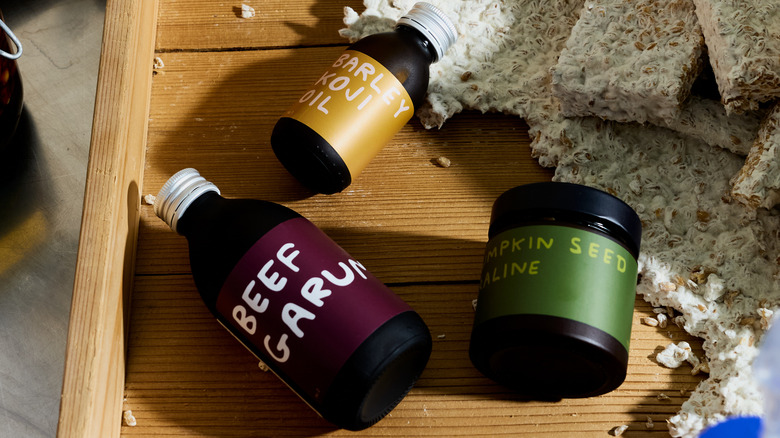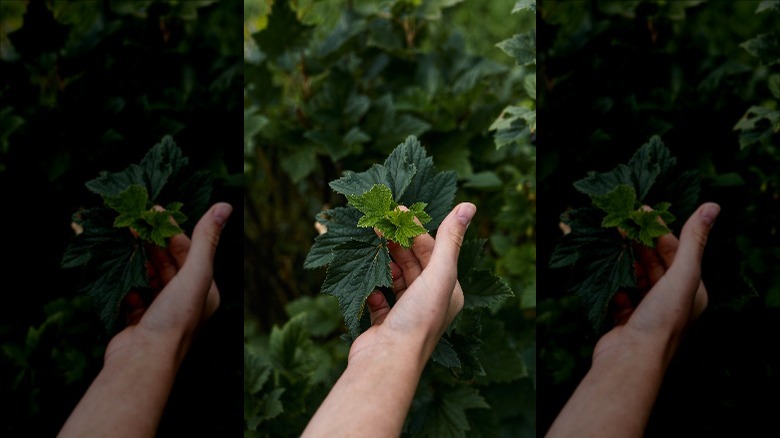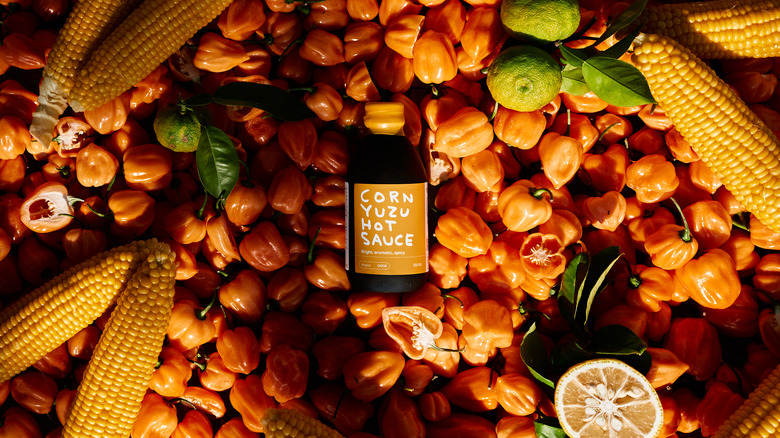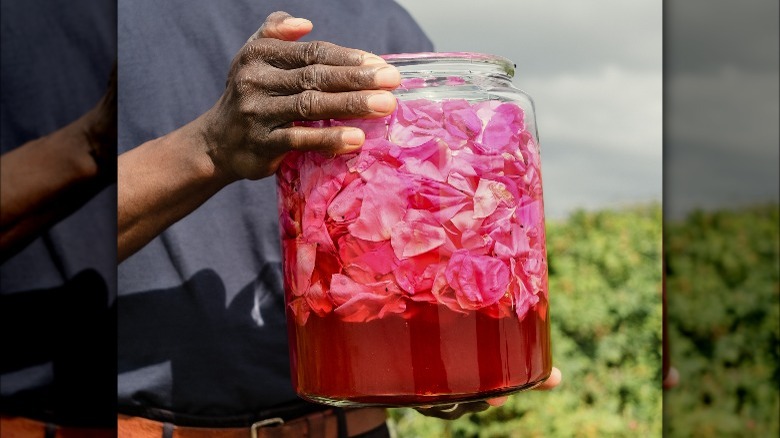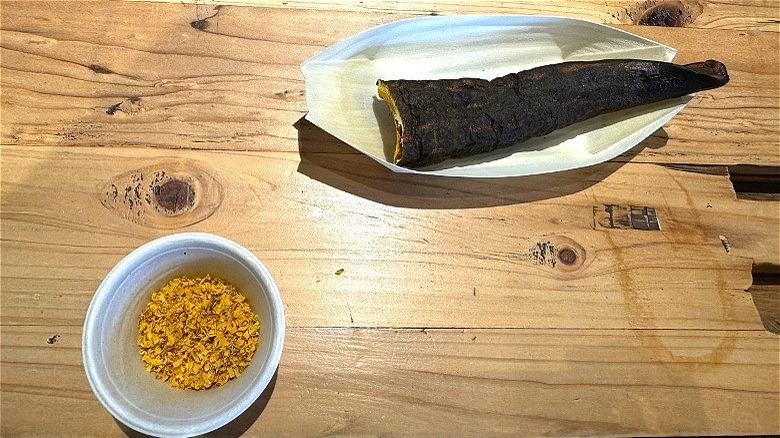Noma Projects Spills The Details On New Products And Potential Plans - Exclusive Interview
Widely considered the best restaurant in the world (and officially crowned with the title multiple times), fine dining fans were stunned when Noma shared plans to close. But there was hope on the horizon, as with that came the announcement of Noma Projects, the restaurant's e-commerce brand. Though almost exclusively accessible online, Noma Projects did an irl pop-up in London for one night only back in September of 2023 and recently came to New York for a week of events. While the Noma team was visiting the Big Apple, we had a chance to learn about upcoming projects and product drops; how to score a coveted spot on the "Taste Buds" roster, a group that is sent advance and unreleased products to sample and give feedback on; and tips for trying your hand at some of the Noma recipes.
At the events hosted by Superiority Burger in New York City's East Village and Dashi Okume in Brooklyn's Greenpoint neighborhood, we spoke to Noma chef of research and production for fermentation, Kevin Jeung; partner and creative director Thomas Frebel; and CEO of Noma Projects/ COO of Noma restaurant Lena Hennessy. While you may not be able to score a spot at the table or tour of the Copenhagen restaurant, they gave us valuable insight on how to recreate a bit of the Noma magic at home.
Noma Projects partners with people that inspire them
A lot of the pop-ups you are doing in New York are at vegan or vegetarian restaurants, is there a reason you chose meat-free establishments?
Thomas Frebel: To be honest we were looking at places that excite us and also where we are hoping to meet new people. Places where we see ourselves going to shop and eat. ... Unfortunately, we only have four days, otherwise there would have been quite a few others. That's where it started. And René [Redzepi] and Brooks [Headley, of Superiority Burger] are very good friends.
I was very, very lucky to come here [Superority Burger] on Tuesday. I loved everything, I loved the sides, loved the burgers. It's one of those places I would come back to probably twice a month. And after eating here I was so excited just to not be the control freak I am sometimes, and to go be inspired by someone else, let him and his team do whatever they do because it is incredible.
Was the menu a collaborative thing or did you give them the products and let them go for it?
Frebel: He [Headley] did his thing.
Kevin Jeung: When a guy like that is making something you just let him cook. He knew right away, we had a Zoom meeting with him and he was like "So this is what we're going to do," and I said "Alright!" There is a reason the two of us are swanning around the dining room right now, they've got everything on lock. I really want to come back before we leave. The menu is on two sheets of paper: one is highlighter green, one is highlighter pink. The regular menu is pink and when I read it I thought "Is anyone going to order off the green one?" it's such a good menu.
Pumpkin seed praline is coming this fall
Frebel: One particular product used on this trip hasn't been released yet: the pumpkin seed praline. It will be [for sale starting] in October.
So we have our club Taste Buds, which is a small group of people we share things we are very, very excited about with. Because just because we are excited about it doesn't mean the rest of the world is excited about it, and also we sometimes go down a rabbit hole so deep where it's like, one particular serving on this one particular thing and we love it, but in the end, it doesn't translate to the rest of the world. So we share these things with Taste Buds and then, according to their feedback, we decide what to do. Taste Buds loved the pumpkin seed praline.
I wasn't expecting it to be liquid.
Frebel: It's funny you say that, we had a big debate about it. For some praline is a praline; for others a praline is a liquid. And to be honest, we just followed our gut feeling and what we called it intuitively at the restaurant.
Can you explain a bit about how it's made?
Frebel: At the restaurant, we use a lot of fresh-pressed pumpkin seed oil. So every morning we press for the evening service and — I'm not sure if you have seen a nut oil press but you are extracting the oil, which is dripping out the bottom, and then there is a very dry pulp being pushed out on the other end.
Like when you cold press juice.
Frebel: Yes. And it's quite tasteless. So we have lots of pumpkin seed oil leftovers, pulp, and we took it as one of those tasks. How can we repurpose what normally goes into the trash? We thought about it and went "Okay you're extracting oil, and pralines are usually made of nuts or seeds which are high in oil content." Maybe it's a downside, but it could also be a benefit, to dream a different praline. Because now we can add any oil. So we started playing around with different oils that are unique to Noma and we ended up taking the dried pulp and adding green parsley oil, spruce wood oil, and raw sugar, and then stone-grinding it for two days.
Oh wow that's it? The flavor, it tastes like pumpkin pie — which I know is not a thing other places — but it tastes like a really well-made, homemade pumpkin pie.
Noma Projects CEO hints at future plans
Lena Hennessy: It's a really exciting time for Noma Projects, just two years in and so much to share, so much to do. This is our first ever tour to a city, getting to meet people in person, it's just been incredible.
It's very nice because — since Noma is such a big thing, even people who aren't super into fine dining would like to experience it — it's so nice you're able to make it more widely accessible.
Hennessy: Only a handful of people get to experience the flavors and innovations of two decades of Noma each year, and with Noma Projects you get to have it in your own home, in your own everyday cooking. And it's just mindblowing the flavors, they're incredible, really unique. So that's really what we want. To spread the love, spread the experience as far and wide as we can.
Do you have any plans to do a physical location? A more permanent place or a longer pop-up or residency?
Hennessy: if you had asked me last week we would have had a different answer. But given the welcome this week, for sure it's something we're thinking about.
Are you planning to do tours of the test kitchen or classes?
Hennessy: We've done a couple of events like that, had a few people come in and look around. We probably can't open it up too publicly because we would likely be overwhelmed with demand but certainly, we have had some of our Taste Buds come. They've had the chance in N.Y. to spend time with the team and dive into deeper stuff. It's super limited in terms of what you can do in person, but we have also done virtual events. We innovate to share, we don't innovate to hold onto this knowledge, it's for everyone to experience. You can even try to make our products yourself! Even if you fail it's amazing. We love for people to try and make [Noma Projects items] and experiment.
Join Taste Buds and be the first to know about new products
Do you and René select the people for Taste Buds?
Hennessy: Absolutely not! First come first serve. It's an annual membership, we did it for the first time in 2023. We had no idea if it would be 100, 1,000 people, and we were totally overwhelmed with the demand. For the pilot year, we had to cap it but we were able to add more spots for 2024 — that's the season we are in now. We are trying really hard to keep ramping it up so we can bring more and more people on. But yeah first come first serve, it's announced online and people can get on the mailing list and wait for the announcement.
So the group is not a "people we want to know what they think" but a "we want to know what people think" thing.
Hennessy: Yeah! Totally everyone. Noma Projects is for everyone and will continue to be a really big part of the business as Noma goes into the next chapter with more time to travel and focus on creativity and innovation.
How often do you release new products? Is there a plan or just when something is ready ...
Hennessy: To date, it's been more along that line, but the nice problem to have is the Noma test kitchen has thousands of innovations and potential future products so it's more about narrowing down what products will land with people, what can support everyday cooking, what can be scaled up in terms of ingredients that are available or the complexity of production. But this year we are doing something different with the Noma seasons. So three seasonal bundles per year, plus our more staple products. We'll [also] have some extremely limited products where we'll have tiny batches that drop on their own.
So do you send out email blasts when you drop something new?
Hennessy: We do! Subscribers and Taste Buds will first hear about it. Typically we make enough for anyone who really wants it to get it.
How Noma uses an entire black currant farm, branch to berry
Frebel: We rent an entire black currant farm. The black currant season is quite long, so we had to get creative. Originally we just rented the farm because we do unripe black currant capers and the farmer was like, "You guys can have it, but I can't do anything with the rest of the bush because I'm farming black currants for the ripe berries. So you can have the farm and you figure it out." So that's great, but then the problem is you are left with many other things. We have the berries just before summer, and what we also do is, in early spring with the black currant buds just before the bush is starting to produce any leaves we harvest those and use them as a spice, just raw dry. We pick the leaves when they are very, very young so [the plant] becomes bigger.
And we also make what we call black currant oil. In early spring, before the bush starts to produce its first buds or leaves the twigs are full of chlorophyll — incredible. So we harvest half of each plant, which allows the plant to grow and produce everything else we need. And we take that wood, hammer it, and infuse it into oil, then strain it. It's our Nordic olive oil, for lack of a better word.
It's really interesting, I don't know what I expected. It's very ... green?
Frebel: Yes, it's like a very, very young extra virgin olive oil.
It tastes like a tree.
Inside Noma Projects' popular corn yuzu hot sauce and tips for making your own
The corn yuzu hot sauce is so good, everyone was raving about it. How is it smoky? It has a smoky flavor.
Frebel: Maybe because the spiciness comes from grilled habaneros. You're the first person to ask me that question.
Really? I feel like it had a very distinct smoke.
Frebel: So it's corn, grilled habaneros, yuzu skin, roasted yeast reduction — we get baker's yeast and roast it for two hours until it's caramelized and crispy at 160 degrees, and then mix that with our own miso, and that is the umami element. So again, corn, grilled habanero, black currant oil, roasted yeast reduction, and yuzu.
Do you have tips for making hot sauce at home?
Frebel: Just start playing around. This was my first real hot sauce, to be honest, just because we don't have chilis as such. But I would start by getting a variety of chilis, depending on your spice tolerance. Spend a couple of minutes removing the seeds and then either lacto-ferment them or put them in vinegar. Once the hot sauce is done, figure out what you want to do. Do you want a cooked sauce? I always recommend adding sweetness, which is quite helpful, and fat, which helps you not perceive spice and lets you taste the hot sauce better.
You put the fat into the sauce?
Frebel: I would ferment the chilis, make your decision about cooking or raw, and whenever you finalize the hot sauce — whether that is cooking or in a mortar and pestle — just put some olive oil into it. It helps preserve [the sauce] and gives it another layer of flavor, and in my opinion, it will help you taste the chili and hot sauce better.
Noma's rose vinegar is surprisingly uncomplicated
So the rose vinegar, it's like a shrub, you put it in a drink. Do you have tips for making one at home?
Frebel: In terms of pure production — taking the labor aside as it takes a lot of hands to harvest the roses, we pick the roses at the shorelines of Scandinavia — we have one liter of unpasteurized apple vinegar and 250 grams of rose petals. We put them in a tank and infuse for six weeks minimum and then we strain it. It varies how sweet or not sweet people enjoy it I like to make it less sweet, at least as an ingredient, because you can always add sweeteners. And that's pretty much it. Go to your store, get your favorite apple vinegar, and find roses
You could use other ingredients too?
Frebel: Yes we also do it with elderflowers, really, really tasty. Those are our two main ones
But you could do with strawberry, plum, whatever as long as you keep the fruit submerged with a fermentation weight.
Frebel: Yeah, though with that said you need to be careful the moment you add other things, because if the acid level gets too low it may ferment over. So you need to be careful but in general, it should be fine.
Just taste it often during the infusion process?
Frebel: Yeah.
A sneak peek at an upcoming Noma Projects release
Is there anything coming up that you can talk about or you're excited about that isn't out yet?
Frebel: There are quite a few things, I'm not sure what I can talk about. Obviously the seasonal bundles ... for the moment we are working on this pumpkin bushi, vegan parmesan thing. Have you heard of katsubushi [a dried Japanese fish product you shave over food]? We were inspired by the process of making katsubushi and researched how to apply the same technique to vegetables. We did like 100 different fruits and vegetables, and without a doubt the best one is pumpkin. So what we have is a quarter of a 3.5-kilo pumpkin. We treat it like a piece of meat, seeing every day how ripe it is. Is it ready, does it need more time? When does it have the best sweetness? (Because sweetness is quite important for this type of thing.) And whenever it's ready it's butchered, we scrape out the pumpkin seeds, and then smoke it for 6 weeks, and then this is what is leftover.
What do you smoke it with?
Frebel: Cherrywood. And then you grate it like Parmesan, a little goes a long way
It smells amazing. It's a little sweet from the pumpkin but very smoky.
Frebel: Yes, it's good grated over rice, on pasta, on potatoes. It's something I'm very excited about, but having said that just because I'm excited doesn't mean the rest of the world is. Maybe it doesn't translate. But I think ... because there is so much value in such a little piece: you only need like half a gram per person, it's shelf stable, it's vegan, very flavorsome. So let's see! I'm working on it. [Dashi Okume staff] were excited about it, they asked if they can keep it in the store, so that's a good sign.
